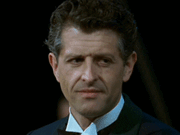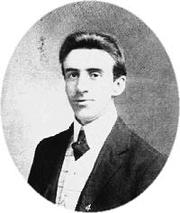
Wallace Hartley during the sinking
Wallace Henry Hartley (2 June 1878 – 15 April 1912) was an English violinist and the bandleader on the RMS Titanic during its maiden voyage. He became famous for leading the eight member band as the ship sank on 15 April 1912. Hartley perished in the sinking.
In James Cameron's film, Titanic, Wallace Hartley was portrayed by Jonathan Evans-Jones.
Life and career
RMS Titanic
Sinking and death

Wallace Hartley in history
After the Titanic hit an iceberg and began to sink, Hartley and his fellow band members started playing music to help keep the passengers calm as the crew loaded the lifeboats. Many of the survivors said that he and the band continued to play until the very end. None of the band members survived the sinking and the story of them playing to the end became a popular legend. One survivor who clambered aboard 'Collapsible A' claimed to have seen Hartley and his band standing just behind the first funnel, by the Grand Staircase. He went on to say that he saw three of them washed off while the other five held on to the railing on top the Grand Staircase's deckhouse, only to be dragged down with the bow, just before Hartley exclaimed, "Gentlemen, I bid you farewell!" A newspaper at the time reported "the part played by the orchestra on board the Titanic in her last dreadful moments will rank among the noblest in the annals of heroism at sea."
Though the final song played by the band is unknown, "Nearer, My God, to Thee" has gained popular acceptance. This song comes in three main versions (and five other alternate versions): the American version ("Bethany"; used in the 1943 film Titanic, the Jean Negulesco's 1953 film Titanic and James Cameron's 1997 Tianic.), the British version ("Horbury" version was played in Roy Ward Baker's 1958 movie about the sinking, A Night to Remember) and the British Methodist version ("Propior Deo"; currently not yet played in any Titanic movie to this date).
Sometime around 2:05-2:10 a.m. as the Titanic began it's last plunge into the icy North Atlantic, the sounds of ragtime, familiar dance tunes and popular waltzes that had floated reassuringly across her decks suddenly stopped as Bandmaster Wallace Hartley tapped his bow against his violin. Hartley and his musicians, some of them wearing their lifebelts now, were standing back at the base of the second funnel, on the roof of the First Class Lounge, where they had been playing for the better part of an hour.
There were a few moments of silence, then the solemn strains of a hymn began drifting across the water. It was with a perhaps unintended irony that Hartley chose a hymn that pleaded for the mercy of the Almighty, as the ultimate material conceit of the Edwardian Age, the ship that “God Himself couldn't sink,” foundered beneath his feet. As the band played, the slant of the deck grew steeper, while from within the hull came a rapidly increasing number of thuds, bangs and crashes as interior furnishings broke loose, walls and partitions collapsed–the Titanic was only eight minutes from breaking apart, then the entire band was washed away by a sudden wave.
At first, it was said that the last music played by the Titanic‘s band was either the Episcopalian hymn “Autumn” or the popular waltz “Songe d’Automne.” However, the evidence for this rested solely on the uncorroborated testimony of wireless officer Harold Bride, who told a reporter for the New York Times that the last song he remembered the band playing was called “Autumn.” This is a brief part of his testimony:
“From aft came the tunes of the band. It was a rag-time tune, I don’t know what. Then there was “Autumn”…The big wave carried the boat off. I had hold of an oarlock, and I went off with it…The ship was gradually turning on her nose—just like a duck does that goes down for a dive. I had only one thing on my mind—to get away from the suction. The band was still playing. I guess all the band went down. They were playing “Autumn” then…The way the band kept playing was a noble thing. I heard it while still we were working wireless, when there was a ragtime tune for us, and the last I saw of the band, when I was floating out in the sea with my lifebelt on, it was still on deck playing “Autumn.” How they ever did I cannot imagine."
Bride, though, was the only person with that recollection, he only mentioned it once, and he never specified if he meant the hymn or the waltz. Moreover, despite the credence given him by some later historians, Bride was never the most reliable or consistent witness, and here his “memories” have to be taken with a rather large grain of salt. Tellingly, neither piece of “Autumn” music, the hymn or the popular waltz, is listed in the White Star Line’s music book for 1912. Also significant is that the hymn is not called “Autumn,” only the melody (much like the melody of the hymn “O God, Our Help in Ages Past” is known as “St. Anne’s”), and usually only a professional musician will refer to a piece of music that way–certainly not an 18-year old wireless operator. So without some sort of supporting or collaborating evidence, any piece of music named “Autumn” can be dismissed as the Titanic‘s orchestra’s last musical performance.
A very strong case can be made, however for “Nearer, My God, to Thee,” which legend has always said was the last music played aboard the Titanic. It is commonly believed to be the last song because there are a number of accounts of survivors who recalled hearing the hymn “Nearer, My God, to Thee,” and therein lies a tale. Commentators who have rigidly committed to the “‘Autumn theory’” are quick to point out that there are two melodies associated with “Nearer My God to Thee;” one (“Bethany”) is American, the other (“Horbury”) is British, the two sound distinctly different from each other and are impossible to confuse–yet both American and British survivors claimed to have heard “Nearer My God to Thee” being played by the ship’s orchestra. What those same commentators fail to mention is that there is a third melody for “Nearer My God to Thee,” called “Propior Deo,” composed by Sir Arthur Sullivan, and it is here that the mystery of the last music played by Wallace Hartley and his fellow musicians finally begins to unravel itself. The melody “Propior Deo” would have been well known to the British passengers aboard the Titanic, and in passages it sounds very similar to “Bethany”–and nothing at all like “Horbury.” In the noise and confusion of the night, it would hardly be surprising if both Americans and Britons, hearing only snatches of music, would both believe that they were hearing the version of “Nearer, My God, to Thee” with which they were most familiar. All the members of the Titanic's band, save for one French member, were British. Thus the American version is out of the question. The leader of the band, Wallace Hartley, was a Methodist, and so was yet another member of the band. And so the possible versions of "Nearer My God To Thee" that could have been played that night are the British and the British Methodist versions.
Moreover, “Nearer My God to Thee” was known to be a favorite of Hartley’s–who was also a friend of Sir Arthur Sullivan and who liked Sullivan’s music–and it was the hymn played at the graveside of all deceased members of the Musician’s Union. Perhaps most convincing of all is a report in the Daily Sketch on April 22, 1912, where a colleague of Hartley’s recalled how some years earlier, while working aboard the Mauretania, he asked Hartley what he would do if he found himself on the deck of a sinking ship. Hartley replied that he would assemble the ship’s orchestra and play “O God Our Help in Ages Past” or “Nearer, My God, to Thee.” Somehow, taken all together, “Nearer, My God, to Thee” seems definitive enough.
Aftermath
Hartley's body was recovered by the Mackay–Bennett almost two weeks after the sinking. He was transferred to the Arabic and sent to England. Hartley's funeral took place in Colne on 18 May 1912. One thousand people attended his funeral, while 40,000 lined the route of his funeral procession.
Hartley is buried in Colne, where a 10-foot headstone, containing a carved violin at its base, was erected in his honour.
A memorial to Hartley, topped by his bust, was erected in 1915 outside the Albert Street Methodist Church in Colne where Hartley began his musical career. Hartley's large Victorian terraced house in West Park Street, Dewsbury, West Yorkshire, bears a blue plaque to remind passers-by that this was the bandleader's home.[19] As of 2001, Hartley's name was still being used when naming new streets and housing in the town of Colne. In 2008, the pub chain J D Wetherspoon named a newly acquired hotel in Colne after the bandleader.
Hartley's violin was found on his body, and was recovered. However, it vanished over the decades, but reappeared in an attic in 2006. After it was authenticated and restored, it was sold in 2013 for 1.7 million dollars, making it the most expensive Titanic artefact ever sold.
External links
Wallace Hartley on Wikipedia
- Wallace Hartley at Find a Grave
| This page uses Creative Commons Licensed content from Wikipedia articles (view authors). |